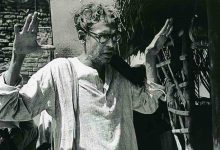Walking down the roads of Calcutta very many years ago, a college youth remarked to his friend, “If I can make an Assamese cinema I would attain salvation.” Thus began the history of Assamese cinema.
The incident happened at the beginning of the second decade of the last century. The author of these words, and the architect of the Assam film industry, was Jyotiprasad Agarwala. It was the age before the birth of the sound movie, and world cinema was still in its infancy. At such a crucial time, Jyotiprasad dreamt of producing a sound movie and went to Germany to be trained in the art of filmmaking. One fine day, he returned from Germany, built a studio in Bholaguri Tea Estate, captured the scenes there, edited the film in Lahore, and released the first Assamese film in Rounak Hall in Calcutta in the March of 1934—four years after the birth of the sound movie in India. The film was about a rebellious female character of Assam history. This periodic and big budget film was more mature and rich in literary qualities than the majority of other Indian films of that era.
It would be relevant to say that Jyotiprasad who was interested in a new medium such as cinema was an earnest worshipper of newness and a sincere devotee of novelty and innovation. He effervesced Assamese music with newness. His songs were, and still are, popularly known as ‘Jyotisangeet’. And he imported new spirit and lustre to both the body and soul of Assamese drama. Jyotiprasad’s ‘Joymoti,’ the pioneer Assamese film, is but a part of this devotion to art. The film was released in Guwahati Theatre Hall on March 20, 1935, and went on to be screened at various other places in Assam. The production cost of the film was fifty thousand rupees, but it could earn only twenty thousand rupees. His second film, ‘Indramalati’ was made with a consolidated budget. The film was not only a commercial success, but also relieved the producer from the financial burden of the earlier film, ‘Joymati’. As the film was made investing scanty money it lacked in production values and technical beauty, but Jyotiprasad did not compromise on the the beauty of the story and the narrative bounty. It is essentially a love story set around India’s freedom movement. The story also raised a zihad against the issue of untouchability, and comprised some scenes of solidarity between the hills and the plains. Though Indramalati was made to capture the mass market, Jyotiprasad had not strayed away from his duty as an artist. Worshipping beauty was not the ends and means of his life. In addition to being a devotee of culture, he was also a fearless freedom fighter. He composed songs to arouse nationalism and to inculcate patriotic feelings among all Indians. These songs are a part of the indispensable wealth of Assamese culture. It is a blessing that the cinema of Assamese was created out of hope, and by such a highly responsible, educated, and visionary artist, in a proper, succinct way.
Assamese cinema has now passed 78 years, but the journey has not carried on smoothly. The limitation of the scope of screening Assamese cinema always creates depression; for this reason, Assamese films cannot become commercially successes. This medium of art depends on heavily on machines and demands huge amounts of money for production. Hence, there is less scope of minimizing the budget. Yet, Assamese films are made by some people because of their passion for it or due to somebody’s natural instinct for self-revelation. Only a few films are able to get back the money spent for its production. The same problem is faced by other regional films of India in regions that are not very populous. To help Assamese cinema, the state government had earlier taken a few important steps such as establishing a film studio with government aid, setting up of a film corporation for the development of cinema and establishing a centre of film education. Recently, the state government of Assam took a decision to extend financial aid of the same amount earned by an Assamese film as entertainment tax. I was announced that the said amount would be paid back within a year of the film’s release. Among all the above-mentioned handouts, producers showed the most interest in getting back from government the cumulative amount of money that the film earned as entertainment tax.
Initially, genuine producers profited from this help extended by the government, and they were able to produce more films with the tax returns. Eventually, though, this got turned into a black market racket. Dishonest producers began polluting the whole process by adopting dubious tactics. On tax papers, they showed that Assamese films were screened at the night shows. In reality, third-rate films were screened instead, and the tax collected from these screenings were claimed as entertainment tax of the supposed Assamese films. This unhealthy practice was conducted by producers with the help of exhibitors as well as corrupt tax officials. As a result, the whole procedure of financial assistance extended by the government grew mighty slow and tedious.
As stated earlier, the shooting of the first Assamese film was done in the studio built by Jyotiprasad Agarwala in Bholaguri Tea Estate. Since the commercial returns were not fruitful, he did the works of his second film in Calcutta. At that time, Calcutta was the centre of producing Assamese movies. Assamese filmmakers were required to take shelter in Calcutta not only for shootings and settings but also for the help of the film technicians of Calcutta. Thus, the Jyoti Chitraban Studio, named after Jyotiprasad Agarwala, was established in Guwahati under the aegis of the Assam Government, to decrease the dependency of Assamese films on Calcutta.
At such a crucial juncture, an Assamese film producer instead of going to Calcutta, chose to set and shoot his film in ordinary houses in Assam with the help of a few apprentices and learners as well as technical assistants from Assam. The name of Brajen Barua’s film is Dr. Bezbarua. It was a super hit beyond all expectations. Though it is unlikely that the success was primarily due to the real-life local settings, the film nevertheless offered a major moral boost to Assamese filmmakers and freed them of their dependency on Calcutta. Brajen Barua’s innovative mind, his courage to accept the risk of working with a new team of local artists and technicians, and his interest in creating a band of new technical persons; and the beginning of Jyoti Chitraban—the conglomeration of these two things brought novelty and excitement. Consequently, the production of Assamese films immensely increased.
In the film industry, the film director is responsible for all the things that make up his film. They are therefore ideally required to be talented to some extent in all related fields. Brajen Barua was such a talented artist. Before coming to the film world he was a singer, and he began his film career as a music director and an actor, in ‘Smritir Parash’ (The Touch of Memory). The director of this film was his brother Nip Barua. Eminent Assamese poet Keshav Mahanta too appeared as a composer of songs in it. And Ramen Barua lent his voice for this film. All these geniuses came from the same family, which eventually became famous as the ‘Barua family’ in Assam. Following this film, Brajen Barua took to directing films, leaving music in the hands of his brother Ramen. In addition to being a singer and a music composer, the latter discovered quite a few singing legends. Ramen later gave up singing and introduced another brother, Dipen, to the music world of Assam. Dipen Barua continues till date to be a successful playback singer. He has also tasted success as a screenplay writer and a director. Two other brothers, Niren Barua and Girin Barua, are connected to the film world as assistant director and actor. And a few young men of the next generation of the Barua family too have associated themselves with the film world in some way.
Brajen Barua was a multifaceted genius—a poet, music composer, storywriter, screenplay writer, actor and director. As an actor, his extraordinary roles in ‘Dr. Bezbarua’ and ‘Opaja Sonor Mati’ created two immortal characters. But why he acted only in his brother Nipa Barua’s films as well as in his own films is still a mystery. The music director of Nipa Barua’s first few films was Brajen Barua; Ramen Barua joined him as the director of music in the films of the second part of his career. In one of his films Anupam Choudhury appeared as a music director. Why Ramen Barua did not work in that film is also another riddle.
Bhupen Hazarika entered the arena of Assamese film in his very childhood as singer and actor in ‘Indramalati’, the second film of Jyotiprasad Agarwala. Then, in ‘Siraj’, the sixth Assamese film, he assisted Vishnu Rbaha with two of his songs; he wrote the songs and composed the tunes. He worked as an independent music director in ‘Sati Beula’, the 10th Assamese film. This was the beginning. After that he directed music in Bangla, Hindi and Bhojpuri films. From music direction to film direction he manifested his extraordinary expertise and transformed one of his radio-play to an exquisite film ‘Era Bator Sur’. There were lots of autobiographical elements in ‘Era Bator Sur’. The presence of some well-known artists of Mumbai gave another dimension to the film. This was the first Assamese film that built a bridge between Assamese and Mumbai film world. Bhupen Hazarika was the first Assamese professional artist who had resigned from a university job and went outside Assam. Besides contributing to Assamese music and culture, he produced a number of brilliant films to his credit. He is the only Assamese artist honoured with the Dada Saheb Falke Award.
The number of directors who later on look forward to producing films is relatively high in Assamese cinema. The music director of the third Assamese movie ‘Manomati’ later on made ‘Badan Barphukan’, the fourth film of Assam. He was not the director of music in that film; Gaura Goswami lent his music to it. From a music director, Bhupen Hazrika too turned a film director. Bhupen Hazrika was the second one who transformed from a music director to a film director. Brajen Barua stood third in this row. One popular music director Upen Kakoti also produced films. Jubin Garg, Nayanmani Barua, and Sadananda Gogoi too began to make films after working as a music director in a few films. Only Brajen Barua retired from music direction after he had begun his career as a director of film.
Some camerapersons later turned into film directors. In the history of Assamese cinema, Sujit Sinha, Bhabani Nath and Nalin Duwerah are a few names to cite. Nalin Duwera’s ‘Mamota’ made on sylvan settings with a low budget manifests his excellence in filmmaking. For lack of money he did not go to a studio for recording of the music of ‘Mamota’. Instead, he recorded the music in an open field while all were sleeping. The music duo Basanta-Manik who lent their music to ‘Mamota’ later on created many immortal songs. Another renowned Assamese music duo was Kula-Atul.
Coming back to Mamota, it must be said that Rudra Barua won the National Film Award –Special Jury Mention for his heart touching acting. This was the first national level award won by an Assamese film. But Rudra Barua became popular only as a musician, for his new style of singing. At the National Film Awards, the first winner of the best regional film was ‘Piyali Phukan’, directed by Phani Sarmah. From that time onwards, Assamese films have been able to carry off awards for regional films. In film direction, Assamese cinema has won awards twice; but more awards are received in the field of film criticism. Assam is the recipient of five Swarna Kamal and two Jury Special Mention Awards for film criticism, and with such honour, Assam, no doubt, enjoys a prestigious place.
At the International Film Festival of India too, many Assamese films since the time of Bhabendranath Saikia’s ‘Sandhyaraag’ have made it to the Indian Panorama category.
Quite a number of notable awards, a few commercially successful films, and a certain amount of government aid, on one hand; and on the other, innumerous commercial flops, and failure to win prizes for artistic excellence—with these two extremes, Assamese cinema is well on its way to touch eighty years. The present hot discussion in the Assamese media with respect to Assamese films is that a market for it is near nonexistent and that, therefore, to set out to make an Assamese film is to set out to make a loss. Ironically, even though there is a lack of audience for Assamese films, and many Assamese films may not even have the opportunity of a week of screening in the cinema halls, a decent number of Assamese films are still being produced in Assam. Perhaps, this is the inexplicable magic of cinema—the unavoidable, endless passion of the film world—maya.
See also:
https://filmcriticscircle.com/journal/jyotiprasad-agarwala-and-his-film-joymoti/
https://filmcriticscircle.com/journal/new-wave-in-cinema-of-northeast-india/






Leave a Reply
You must be logged in to post a comment.